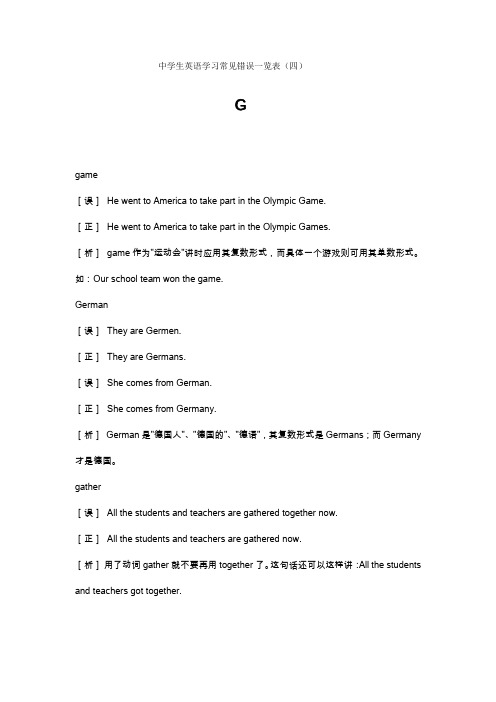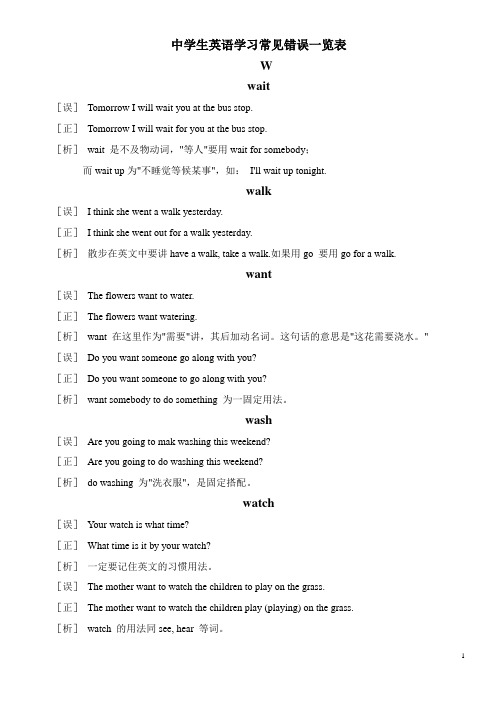中学生英语学习常见错误一览表4
- 格式:doc
- 大小:79.50 KB
- 文档页数:43

中学生英语学习常见错误一览表(四)Ggame[误]He went to America to take part in the Olympic Game.[正]He went to America to take part in the Olympic Games.[析]game作为"运动会"讲时应用其复数形式,而具体一个游戏则可用其单数形式。
如:Our school team won the game.German[误]They are Germen.[正]They are Germans.[误]She comes from German.[正]She comes from Germany.[析]German是"德国人"、"德国的"、"德语",其复数形式是Germans;而Germany 才是德国。
gather[误]All the students and teachers are gathered together now.[正]All the students and teachers are gathered now.[析]用了动词gather就不要再用together了。
这句话还可以这样讲:All the students and teachers got together.give[误]She gives up to look for the lost bike.[正]She gives up looking for the lost bike.[析]give up意为"放弃",其后只接动名词作介词宾语,而不应接不定式。
glad[误]His parents were very glad for his success in business.[正]His parents were very glad of his success in business.[正]His parents were very glad to know his success in business. [析]"为……感到高兴"应是be glad of something或be glad to do something. glass[误]The old teacher has two pair of big glass.[正]The old teacher has two pairs of big glasses.[析]glass作为"眼镜"讲,应用复数形式,在英语中手套gloves 裤子pants,剪刀scissors均用复数形式。

英语学习中的常见错误及避免方法Common Errors in English Learning and How to Avoid ThemIntroduction:English learning has become increasingly popular, with more and more individuals around the world striving to improve their language skills. However, there are several common errors that learners tend to make. In this article, we will address these errors and provide effective strategies to avoid them.1. Mistake: Incorrect PronunciationPronunciation plays a vital role in effective communication. Many learners struggle with pronouncing certain sounds and words accurately, which can hinder their ability to convey their intended meaning.Solution: Listen and PracticeTo improve pronunciation, it is essential to listen to native speakers as much as possible. Pay attention to the sounds they make and imitate their pronunciation. Regular practice, through activities such as repeating phrases, tongue twisters, and using pronunciation apps or websites, can significantly enhance your pronunciation skills.2. Mistake: Overusing TranslationRelying too heavily on translation is a common mistake made by English learners. Constantly translating words from their native language to English can lead to unnatural sentence structures and hinder fluency.Solution: Think in EnglishInstead of translating word for word, try to think directly in English. Surround yourself with the language, think in English throughout the day, and immerse yourself in English-speaking environments. This method will help you develop fluency and produce more natural sentences.3. Mistake: Incorrect Word OrderWord order is crucial in English sentences. Many learners make mistakes by arranging words in the wrong order, leading to confusion or miscommunication.Solution: Study Sentence StructureFamiliarize yourself with basic sentence structures in English. Understand the subject-verb-object pattern and practice constructing sentences accordingly. Reading English books, articles, and listening to English podcasts can also help you grasp the correct word order.4. Mistake: Limited VocabularyHaving a limited vocabulary can make English learning challenging. It limits your ability to express yourself accurately and may result in difficulties understanding others.Solution: Expand Your VocabularyMake it a habit to learn new words every day. Utilize various vocabulary-building techniques, such as reading books, watching English movies or TV shows, and using online vocabulary resources. Additionally,practice using new words in sentences to reinforce your understanding and usage.5. Mistake: Neglecting GrammarGrammar is the backbone of any language, and neglecting its importance can hinder effective communication. Many learners make grammatical errors that affect their overall language proficiency.Solution: Study and Practice GrammarDedicate time to study English grammar systematically. Utilize grammar books, online resources, and language learning apps to enhance your understanding. Practice through exercises and seek feedback from native English speakers or teachers to correct your mistakes.Conclusion:By becoming aware of these common errors in English learning and implementing the suggested solutions, learners can significantly improve their language skills. Remember, consistent practice, exposure to the language, and a willingness to learn from mistakes are key factors in achieving success in English learning. Keep striving and never hesitate to seek guidance when needed.。

英语学习中常见的错误及纠正方法在英语学习过程中,学生们常常会犯一些错误。
这些错误可能是由于语法不熟悉、发音困难、词汇使用错误等原因造成的。
本文将列举一些常见的错误,并提供相应的纠正方法,帮助学生们更好地提高英语水平。
1. 语法错误语法错误是英语学习中最常见的错误之一。
学生们可能会在句子结构、时态使用、主谓一致等方面犯错。
要纠正这些错误,学生可以多参考语法书籍、教学视频等资源,加强对基础语法知识的学习和理解。
此外,也可以多做语法练习题,通过实践来巩固已学的语法知识。
2. 发音错误发音错误常常影响到学生们的口语表达能力。
一些音素对于非母语学习者来说比较困难,例如英语中的/θ/ 和/ð/ 音。
为了纠正发音错误,学生可以借助语音教材、曲折发音的单词列表等资源,模仿标准的发音,反复练习。
同时,也可以利用各种在线语音纠正工具,不断自我纠正发音。
3. 词汇错误词汇错误表现为学生使用错误的词汇或者词汇搭配不准确。
为了纠正这些错误,学生可以提前准备好相关的词汇和短语列表,并注意使用正确的语境来学习和应用这些词汇。
此外,积极参与英语对话,与他人进行交流,增加在实践中使用词汇的机会,有助于提高准确性和流利度。
4. 拼写错误拼写错误是学生们常犯的错误之一。
为了解决这个问题,学生们可以多做拼写练习题,并可以使用一些在线拼写纠正工具。
此外,建议学生们在写作时经常检查自己的拼写错误,为此可以先写一篇作文,然后再仔细检查错误之处。
通过不断地练习和自我检查,拼写错误会逐渐减少。
5. 缺乏语言环境缺乏语言环境是很多学生学习英语时的一个挑战。
为了解决这个问题,学生们可以积极寻找语言环境,例如参加语言交流活动、与英语国家的朋友交流、通过在线论坛进行英语交流等。
此外,多看英语电影、听英语音乐、阅读英语文章等也可以帮助学生们融入到英语环境中,提高语言的学习效果。
6. 学习方法错误学习方法的选择也是影响学习效果的重要因素。
有些学生可能采取了不适合自己的学习方法,导致学习效果不佳。

理解中学英语中常见错误和误区的六个例子中学时期,学生们在学习英语过程中经常会遇到一些常见的错误和误区。
这些错误和误区可能会影响他们的英语学习进程,因此理解并纠正这些错误至关重要。
本文将列举六个在中学英语学习中常见的错误和误区,并提供相应的解释和改正方法。
1. 直译错误许多学生在翻译英语句子时会直接进行中文的直译,这会导致句子意思的混乱和语法的错误。
例如,当学生遇到"I am going to school"这个句子时,他们往往会错误地直译为"我是去学校",而正确的翻译应该是"我要去学校"。
解决这个问题的方法是培养学生理解整个句子意思的能力,而非仅仅依赖字面意思的直译。
2. 时态混淆时态是英语中重要的语法部分,但很多学生往往会混淆各种时态的用法。
例如,学生可能会在描述过去事件时使用了现在时,或者在描述将来事情时使用了过去时。
为了纠正这个错误,教师应该引导学生掌握各种时态的用法,并提供大量的练习机会。
3. 宾语和主语的混淆中学生在描述事件时,常常会搞混宾语和主语的位置,导致句子的语法错误。
例如,学生可能会说"I like he"而不是"I like him"。
为了纠正这个错误,教师可以通过练习和示范来帮助学生理解宾语和主语在句子中的正确位置。
4. 拼写错误中学生常常在英语的拼写方面出现错误,这可能是由于中文和英文的拼写规则不同所导致。
例如,学生可能会将"freind"错误地拼写成"friend"。
为了改正这个问题,教师可以进行大量的拼写练习,并提供相关的拼写规则和技巧。
5. 语法错误英语的语法是学生常常犯错的另一个方面。
学生可能在单复数形式、主谓一致等语法问题上出现错误。
一个解决这个问题的方法是引导学生学习基本的语法规则,并提供一些常见的语法错误的例子和纠正方法。

中学生英语学习常见错误一览表Wwait[误]Tomorrow I will wait you at the bus stop.[正]Tomorrow I will wait for you at the bus stop.[析]wait 是不及物动词,"等人"要用wait for somebody;而wait up为"不睡觉等候某事",如:I'll wait up tonight.walk[误]I think she went a walk yesterday.[正]I think she went out for a walk yesterday.[析]散步在英文中要讲have a walk, take a walk.如果用go 要用go for a walk.want[误]The flowers want to water.[正]The flowers want watering.[析]want 在这里作为"需要"讲,其后加动名词。
这句话的意思是"这花需要浇水。
" [误]Do you want someone go along with you?[正]Do you want someone to go along with you?[析]want somebody to do something 为一固定用法。
wash[误]Are you going to mak washing this weekend?[正]Are you going to do washing this weekend?[析]do washing 为"洗衣服",是固定搭配。
watch[误]Y our watch is what time?[正]What time is it by your watch?[析]一定要记住英文的习惯用法。

初中英语中常见错误分类总结在学习英语的过程中,初中生们常常会犯一些错误,这些错误可能源于语法的不熟练、词汇的不掌握等多种原因。
本文将对初中英语中常见的错误进行分类总结,帮助初中生们更好地掌握英语。
一、词汇错误1. 拼写错误很多初中生在面对英语单词时经常出现拼写错误的问题,原因可能是因为他们不善于记忆或不注重拼写的规则。
举个例子,有一些单词拼写可能会让人产生困惑,比如“accommodation”和“basement”,这时候我们需要用到记忆技巧和规则来帮助我们掌握这些单词。
2. 用词错误初中生们有时会不知道该用哪个词,比如“I like the music very much”和“I like the song very much”,虽然这两句话的意思相同,但是music与song的意思不同,容易引起误解。
因此,在学习英语时,我们需要注重词汇的积累和理解,这样才能正确地运用单词。
二、语法错误1. 时态错误很多初中生在使用时态的时候会出现错误,比如不能准确区分现在完成时和过去完成时等。
为了解决这个问题,我们可以通过学习语法知识和阅读英文文章来帮助自己更好地掌握正确的时态。
2. 主谓不一致在英语中,主语和谓语是需要一致的,但是很多初中生不注意这一点,造成了主谓不一致的错误。
例如,“I and my family are going on vacation”这句话中,I和my family不应该用are连接,而应该用is连接。
3. 从句错误在复合句中,从句的运用很容易出现错误,比如语序、连接词使用不当等。
为了避免这种错误,我们可以积累一些常用的连接词和从句的语序,以及多读多写,多实践来提高自己的能力。
三、语言表达错误1. 中式英语中式英语是指因为直接翻译中文而造成的表达不正确的问题。
例如,“请问你叫什么名字?”,学生可能会直接翻译成“What's your name”的说法,而正确的问法应该是“What is your name?”。
中学生英语学习常见错误一览表4[误][正][析]in经常用于参加某个团体、政党,并作为其中的一个成员;attend则重点强调出会议、到场,而不一定进行具体活动,如:Did u attend the eeting esterda?而tae part in则强调参与某些具体活动或运动,如:I tae part in the ftball gae[误][正][析]ust n意义”刚才”,所以句中的谓语动词要用过去式。
[误][正][析]ust单独使用时不应放在句首,而应放于①be动词之后,如:He is ust a student②名词与一般动词之间。
③用在第一助动词之后,如:I have ust returned he 但ust与其他词组成词组时,如ust n, ust then, 则可用于句首和句尾。
如:ust常用于三种含意:①恰好,如:It’s ust five ‘l ②仅仅,相当于nl, 如:I have ust enugh ne t bu a ditinar ③不久前,如:I ust issed ld friend; He left a fe inutes ag 而ustl其意为”公正的”,如:He as ustl punished fr his riK[误][正][析]“对某人隐瞒某事”要用”eep sething fr sebd”句型。
[误][正][析]eep ding sething为连续不断地做某事。
有时可以与eep n ding sething互换。
它们的区别在于eep ding sething意为该动作一直不停地在进行中,如:hen the train started, she ept aving her hand 而eep n ding sething则表示该动作可能停停顿顿但却一直在进行中,如:He ept n aing the sae istaes in graar[误][正]e ust eep up ith the ti[析]这句话意为”我们必须赶上时代”,eep up ith是”赶上”之意,而eep up则是”坚持下去”的意思,如:[误][正][析]英语中讲某某的东西一般要用f,而e, entrane, anser则多用t,如:”门的钥匙”为e t the dr, “高速公路入口”为entrane t the higha, “问题的答案”为the an[误][正][析]ind在这种句式中应作为主语,如果讲Thse inds f bs are ver gd 则是正确的。
中学生英语学习常见错误一览表Aa[误]I think it is an useful English dictionary.[正]I think it is a useful English dictionary.[析]在不定冠词a 与an 的用法中要注意的一点是:an 用在以元音开头的词之前;而 a 则用在以辅音开头的词之前。
要特别注意的是以u 字母打头的单词,如useful, university 等,其第一个音标是[j],所以要特别予以注意。
[误]I need a hour to finish this letter.[正]I need an hour to finish this letter.[析]要注意hour 和honest 的第一个字母不发音。
[误]My teacher is a unknown man, but he is a very good man.[正]My teacher is an unknown man, but he is a very good man.[析]要注意以u 打头的单词,它的发音为[]时,单数名词前要用an,如uncle 等。
[误]There is a“f”in the word“football”.[正]There is an“f”in the word“football”.[析]英文字母单独使用时,如其第一个发音是元音时,其前面的不定冠词应该用an 而不是a.[误]I have a little brother. He is a 8 year old boy.[正]I have a little brother. He is an 8 year old boy.[析]要注意这些字母的第一个发音为元音,如eight, eleven 等。
able[误]This bike is able to be repaired.[正]This bike can be repaired.[析]be able to 主要表达某事或某人具有某种能力去作某事,应译为“有本领”、“有能力”、“可以”作某事,如:I'm able to swim across this river. 而can 可以用来表示具有接受能力或吸收能力。
中学生英语学习常见错误一览表中学生英语学习常见错误一览表与[误].[正].[析]在不定冠词与的用法中要注意的一点是:用在以元音开头的词之前;而则用在以辅音开头的词之前。
要特别注意的是以字母打头的单词,如等,其第一个音标是[],所以要特别予以注意。
[误].[正].[析]要注意和的第一个字母不发音。
[误], .[正], .[析]要注意以打头的单词,它的发音为[]时,单数名词前要用,如等。
[误]“”“”.[正]“”“”.[析]英文字母单独使用时,如其第一个发音是元音时,其前面的不定冠词应该用而不是.[误]. .[正]. .[析]要注意这些字母的第一个发音为元音,如 , 等。
与[误].[正].[析]主要表达某事或某人具有某种能力去作某事,应译为“有本领”、“有能力”、“可以”作某事,如:' . 而可以用来表示具有接受能力或吸收能力。
如:.[误].[正].[析]要注意是“将要”的意思,含有将来时之意,不要与表示过去时的时间状语连用。
另外,一般用作书面语,对应的口语是. ,与都可以作"关于"讲,但却有所不同,例如: . 应译为“这是一本关于物理学的科普读物。
”而: . 则应译为“这是一本物理学方面的专著。
”[误].[正].[析]表达“在……上方”时,与是可以互换的,如: ( ) . 但是要表达在垂直方向上的上方时则应用不可用,如:.[误].[正].[析]当表达覆盖之意时,只可用而不能用 .[误].[正].[析]用来表达“从……上方越过”时不能用只能用,如: . 但要注意 . 则应译为“在桥的上游有一个瀑布。
”[误].[正].[析]是指某一动作在一平面内进行,而则是指该动作在一三维立体空间的运动过程。
如: . .的主要用法有两个。
其一,意为“对面”,如: . 其二,意为“横过”,如:.[误]' .[正].[析]要注意“害怕”一词在英语中不是动词,而是形容词,要与动词连用。
[误].[正].[正].[析]要表达“在多少时间之后”,英语中有两种表达法,即:用时,要时间在前,如 ; 而用时要时间在后,如。
中学生英语学习常见错误一览表 3 eeach[误]every of them has his habit.[正]each of them has his habit.[析]each可以作形容词,但也可作代词,而every 只能作形容词。
[误]the manager comes to america almost each month.[正]the manager comes to america almost every month.[析]each与every都作形容词讲时,都有"每个"之意,但有不同。
each多指个体,而every那么多指整体。
如:we want every student to succeed. each不同来表达总体概念,所以不能与almost, nearly,likely 等词连用。
[误]we each has a book.[正]we each have a book.[析]each 作同位语时,其数应与其同位的名词一样,而each作主语时那么应取其单数形式。
each other one anothereach other与one another这两个词组的区分在许多语法书中强调each other是两者之间,而one another是多者之间,其实不然,如:all students must care for each other, must love and help each other. 事实上这两个词组是同义的,假如要讲有什么区分的话,当我们特别笼统地谈,而不特指什么人时,多用one another.early[误]could you come here more early?[正]could you come here earlier?[析]单音节和少数双音节副词的比拟级和最高级要用er和est来作其结尾,如fast, soon, early, hard, long, near等。
中学生英语学习常见错误一览表4[误][正][析]in经常用于参加某个团体、政党,并作为其中的一个成员;attend则重点强调出会议、到场,而不一定进行具体活动,如:Did u attend the eeting esterda?而tae part in则强调参与某些具体活动或运动,如:I tae part in the ftball gae[误][正][析]ust n意义”刚才”,所以句中的谓语动词要用过去式。
[误][正][析]ust单独使用时不应放在句首,而应放于①be动词之后,如:He is ust a student②名词与一般动词之间。
③用在第一助动词之后,如:I have ust returned he 但ust与其他词组成词组时,如ust n, ust then, 则可用于句首和句尾。
如:ust常用于三种含意:①恰好,如:It’s ust five ‘l ②仅仅,相当于nl, 如:I have ust enugh ne t bu a ditinar ③不久前,如:I ust issed ld friend; He left a fe inutes ag 而ustl其意为”公正的”,如:He as ustl punished fr his riK[误][正][析]“对某人隐瞒某事”要用”eep sething fr sebd”句型。
[误][正][析]eep ding sething为连续不断地做某事。
有时可以与eep n ding sething互换。
它们的区别在于eep ding sething意为该动作一直不停地在进行中,如:hen the train started, she ept aving her hand 而eep n ding sething则表示该动作可能停停顿顿但却一直在进行中,如:He ept n aing the sae istaes in graar[误][正]e ust eep up ith the ti[析]这句话意为”我们必须赶上时代”,eep up ith是”赶上”之意,而eep up则是”坚持下去”的意思,如:[误][正][析]英语中讲某某的东西一般要用f,而e, entrane, anser则多用t,如:”门的钥匙”为e t the dr, “高速公路入口”为entrane t the higha, “问题的答案”为the an[误][正][析]ind在这种句式中应作为主语,如果讲Thse inds f bs are ver gd 则是正确的。
ind和srt为同义词,意为”种类”,而tpe则为”型号”,如:hat tpe f this ar d u ant?(你想要这种车的什么型号[误]Sene as n[正][析]n虽可以作及物动词,如:The ar ned a hle in the fene 但作”敲门”讲一定要用作不及物动词:[误][正][析]要注意英语中在不定式前加疑问代词或疑问副词的用法。
如:I ant t n h t d it / hat t d /I n hi为”我很了解他。
”而I n f hi 则为”我听说过他。
”同样的用法还有hear和hear f这一词组。
L[误][正][析]“a large nuber f + 复数名词”,意为大量的。
[误]T[正][析]“最新消息”应为latest nes,因为最晚到的新闻才是最新消息,请注意英语与汉语的区别。
[误][正][析]当谈到与目前有关的上月、上星期等概念时只能用last nth, last ee, 而不能加定冠词,the last 可用于表示一系列词的最后一个,如:That as the last hristas I spent at he 但the last可以用表示持续到现在的一个长时期,如:[误][正][析]late即可做形容词又可作副词;而latel则意为”最近的”,如:late有两个比较级,指时间较晚应用later,如口语中常讲:See u later (一会见。
)而latter则指按顺序讲的后者,或靠后的,其反意词为frer,如:the frer president(前总统)。
又如:I an understand the latter part f the str 而latel则意为”近”、”不久前”。
中的at是不可省掉的。
则指”笑着谈论”某事,如e laugh ver the fil (我们笑着谈论那个电影。
[误][正][析]英中有三个动词易混,在考试中也频频出现,它们的现在式,过去式,过去分词以及现在分词是:放躺说谎[误]The teaher said:”u ust stud this pe b hear[正]The teaher said:[析]stud与learn在作”学习”讲时,常常可以互换,但learn侧重于学习成果或初级阶段的模仿性学习,如:The little bab is learning t al 而stud则多侧重于学习的过程,如:I’ studing at this llege 而learn…b heart则是”记住”、”背诵”之意。
[误]I’ll leave Beiing t Sh[正][析]leave fr一词组为”去某地”,如对话中常讲I’ll leave fr Shanghai 因所离开的地点是双方都知道的则可以省略。
[误][正][正][析]如果句中有地点状语则不要用frget, 而要用[误][正][正][析]“我有两节英语。
”这一表达法如上,但美国老师讲他有两节时则多用为”教训某人”,或”要吸取教训”,如:[误][正][析]brr是指”借入”,如:I ant t brr se bs fr the librar lend 是”借出”,如:I an lend u bie 而eep为”借多久”:如[误][正][析]less是little的比较级,而feer是fe的比较级。
要注意前者修饰不可数名词,而后者修饰可数名词。
[误][正][析]虽然let, have, ae有相同的用法,但ae和have含有迫使某人做某事的意思。
[误][正]Let’s g t the par[误][正][析]Let’s g的反意疑问句是shall e?而Let us g的反意疑问句则是[误][正][析]life作为”生命”、”性命”时应为可数名词;当泛指一般”生活”讲时则为不可数名词,如:hih d u prefer, tn life r untr life? 又如:Life[误][正][析]light有两个过去分词:lighted和lit,当用过去分词作形容词当定语时只能用可以用作名词,如:The n gets its light fr the sun 也可以作形容词,如:The lassr is ver light 还可以作动词,如:The little girl lit a ath 作形容词时还有”轻”、”浅”等意,如:[误][正][析]as 作为连词其后要接从句,如:She is a gd student as his brther used t be 而lie是介词,其后接宾语。
[误][正][析]lie作为动词当”喜欢”讲时,其后面可接不定式也可接动名词,用不定式多表达一个一次性的动作,如:I’ srr I dn’t lie t g siing tnight 用动名词则表示一个习惯性的动作,如:作为形容词,alie 一般不作定语,而只作表语,如;The tins are ver[误][正][析]在uld u lie…这一句型中,其后面只能接不定式,而不能接动名词。
的用法还要注意以下两点:①He lies T 为”他喜欢汤姆。
”②He is lie T 为”他像汤姆。
”第二句话的lie为介词,而第一句话的lie为动词。
[误]u shuld he[正][析]hear多侧重于听到某事或某种声音,而listen t则侧重于听的倾向性。
如:e listen but hear nthing 例句为”听取某人意见”,所以只能用[误][正][误][正][析]要注意中英在同一问题上的表达法是不同的。
如中”水不多了,我去取点吧。
”英要讲”没水了,我去取点吧。
little与sall是近义词,在作定语时常常可以互换,如:a little girl或a sall girl,但little一般不作表语,如:The ar ver there is sall 一句中不要用little 作定语时little常常带有感情色彩,而sall则带有对比的含义。
[误][正][误][正][析]“靠吃某物为生”应用live n sething, 而live b是”靠某种生活手段为生”。
living侧重于生活得很好,身体不错,如:grandfather is still living in his eighties 而alive则强调没有死而是活着的,如:Is that at alive r[误][正][析]lnel意为”寂寞的”、”孤单的”,如:The ld an felt lnel alne则意为”独自的”、”单独的”,如:He lives alne but he desn’t feel lnel[误][正][析]lng用作表达时间的副词时,在否定句及疑问句中最常用,但在肯定句中除与s, t, as…as连用外,一般要用[误][正][析]as…as引导的状语从句中可以用一般现在时表示将。
[误][正][析]因为答语为每周一次所以问的是频率,要用h ftenl fr 侧重于“寻找”这个动作,如:hat are u ling fr? 而find则侧重于结果,如:It is ver diffiult t find a b 这里不能用l fr,因为真正困难的是”找到”工作。
其他用法还有:[例][析]l ba n sething 为”回顾”、”回想”。
[例][析]l dn n (upn) 为”看不起”某人或某事。
[误]I’ ling frard t[正][析]l frard t词组中的t是介词,所以其后要加名词或动名词,不能接不定式。
[误][正][析]uh ne多用于疑问句与否定句中,而在肯定句中要用f与a lt f之间无多大区别,两者都可以修饰可数与不可数名词,所以常常可以互换。
[误][正][析]不可用re修饰比较级,能修饰比较级的词有ver uh, a lt, lts, an, n, rather, a little, a bit等。
这两个词含意相同,在日常用语中lud多与tal,spea, shut, laugh等动词连用,如:Dn’t spea s lud,u’ll ae the bab 而在比较正式的场合才用lud多指把声音放大,而alud则指要出声不要默读。